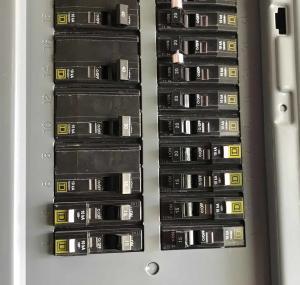I Just Lost Power in Part of my House…What Should I Do?

We’ve all experienced walking in to a room and switching on the lights and nothing happens. Or you could be watching TV and relaxing only to see the TV and lights go out completely. When lights, appliances, or an entire area of your home suddenly stops working, the likely culprit is a tripped circuit breaker. For circuit breaker troubleshooting, the first thing to do is to check your circuit breaker box. A simple inspection should show if one or more of your circuit breakers is pointing in a different direction. If that’s the case, you’ve at least identified the problem. So, what is your next step?
Circuit breakers are designed with your homes safety in mind. If there are issues with your electrical system that could cause overheating, then fire could be a potential outcome. Circuit breakers are designed to “trip” to prevent a potentially devastating situation. You should ask yourself, has this happened before with the same circuit? If so, a more severe problem could exist, and the cause should be investigated immediately. It may be best to contact a licensed electrical contractor to inspect your electrical system.
Electrical Fires Are No Laughing Matter A failing or malfunctioning circuit is a serious issue that can result in fire and other life-threatening hazards!
What are the common reasons for tripped circuit breakers?
One of the GFCI outlets in my home has tripped? – This is a common occurrence. GFCI outlets are distinguished from other outlets as they are designed specifically to protect a person from electrical shock in areas of the home where moisture is prevalent. They are typically found in bathrooms, kitchen’s and garages. GFCI outlets have two buttons, one labeled “test” and the other “reset”. Often, a GFCI outlet in one part of the home like a bathroom, could control other outlets in other rooms. If you notice outlets not working in a bathroom, check the other bathrooms or rooms with GFCI outlets. Sometimes these can be difficult to locate as they may be hidden behind an appliance, furniture or items on a counter. Once you locate the GFCI outlet that has tripped, press the “reset” button. You should hear a click and power should be restored. If you do not hear a click, then there could be other issues that are not allowing the circuit to reset. At this point, you may want to contact a licensed electrical contractor.
You Have a Short Circuit in Your Home’s Wiring or a Ground Fault – Any time a hot wire in your home’s electrical system touches a neutral wire this will trigger a short circuit. This can happen in the wiring itself if wires get frayed, or it can occur in an outlet or appliance. When this occurs, current will flow between the hot and the neutral wire at a high rate of speed which causes overheating. This causes overheating in the circuit and will lead to the breaker tripping. A ground fault is like a short circuit as it occurs when a hot wire crosses a ground wire or comes in contact with a junction box. This produces the same results as a short circuit, rapid current flow that creates overheating in the circuit and the breaker will trip. Don’t hesitate to contact a professional for short circuits or ground faults. If you detect a burning odor or see scorching around outlets and fixtures, cut the power to that specific area of your home and contact a licensed electrician immediately.
Circuit Overload or a Faulty Appliance – If you are using too many appliances at the same time, that are all on the same circuit, you can create a situation where those appliances are drawing more power than the circuit is built to handle. Ask yourself if you were doing anything at the time that may have caused the circuit breaker to trip. Are there multiple appliances in use at the same time such as your washer/dryer, microwave, coffee maker, or perhaps you just turned on your vacuum cleaner? For example, many cabinet mounted microwaves have been added to a home’s kitchen after it was built. Placing this microwave on the same circuit as the oven/range exhaust could max out the circuit if other appliances or lights are all being used on the same circuit. If this is a reoccurring problem, you may want to contact a licensed electrician and have them inspect the circuit in question. By upgrading say from a 15-amp circuit to a 20-amp circuit or installing a dedicated circuit to control some of your appliances you can alleviate future tripping issues. If the cause is a faulty appliance you may be able to determine which appliance is the problem by using them one at a time. You may also notice the appliance itself is unusually warm or smells of burning plastic. If it appears to be an appliance, then you should cease to use it until repaired or replaced.
Is my Air Conditioner causing my breakers keep tripping? – Air Conditioners that are overheating draw more electricity than the circuit breaker can process causing the breaker to trip. The breaker protects your unit from damage or a possible fire by shutting off the power when an overload is sensed. Unless you turned the breaker off yourself, something is causing the breaker to trip. If you can’t determine that turning on a new appliance caused the circuit breaker to trip, it could be an issue with your AC unit. Did your AC unit attempt to come on right before the circuit tripped? Don’t disregard this, something is not right. Be safe and contact a professional to determine the origin of the problem and provide a solution to fix the problem.
Don’t take chances with problems that require a professional electrician to diagnose and fix!
If you need help, contact Jackson Total Service for fast, affordable and efficient service.
